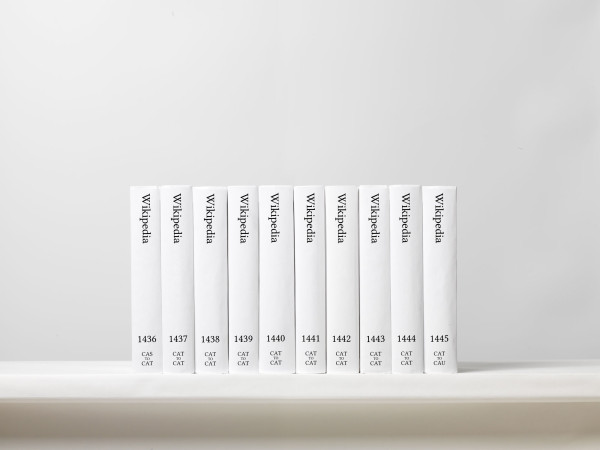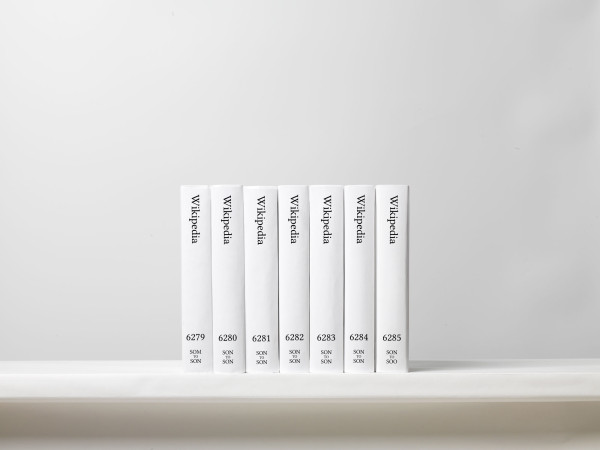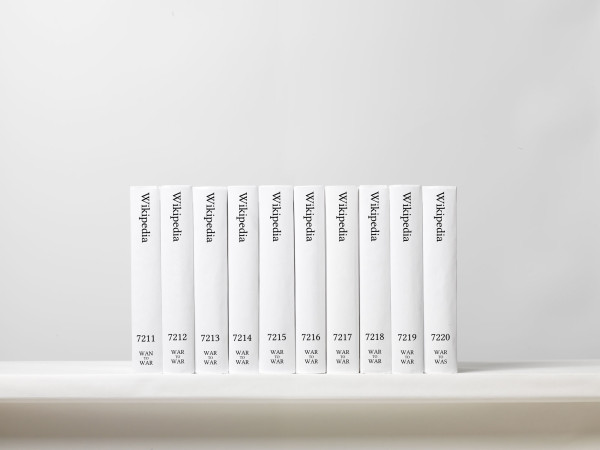Michael Mandiberg
Thursday, 18 June 2015
From Aaaaa! To ZZZap! opening tonight at Denny Gallery.
The Wikipedia entry for “quixoticism” runs only about 255 words. But if anyone could argue for a personal mention, it might be Michael Mandiberg.
For the past three years, he has been fully engaged in a project that might make even the most intrepid digital adventurer blush: transforming the English-language Wikipedia into an old-fashioned print reference set running to 7,600 volumes.
Mr. Mandiberg, an interdisciplinary artist who teaches at the College of Staten Island and the Graduate Center of the City University of New York, describes the project as half utilitarian data visualization project, half absurdist poetic gesture.
“When I started, I wondered, ‘What if I took this new thing and made it into that old thing?’ ” he said in a recent interview in his sparse, white-walled studio in Downtown Brooklyn. “ ‘What would it look like?’ ”
On Thursday, he and the rest of the world will find out, when the exhibition “From Aaaaa! To ZZZap!,” based on his larger project “Print Wikipedia,” opens at the Denny Gallery on the Lower East Side. There, Mr. Mandiberg will hit “start” and a computer program will begin uploading the 11 gigabytes of very compressed data from a Mac Mini to the print-on-demand website Lulu.com.
The upload page at Lulu.com will be projected onto one wall of the gallery, which will remain open around the clock through the weekend and then for more regular hours until the upload finishes roughly two weeks later. For the code-literate, the technical operations will be tracked on a monitor in the gallery and online at printwikipedia.com. For the print-minded, the gallery’s other walls will be lined with wallpaper showing the spines of the first 1,980 volumes in the set, supplemented by 106 actual physical volumes, each of which runs to 700 pages.
Everyone knows that Wikipedia is huge, but it takes the physical book — still a “cognitively useful” unit of measure, Mr. Mandiberg said — to grasp just how huge. He will not, however, be printing all 7,600 volumes.
“We don’t need to see the whole thing in order to understand how big it is,” Mr. Mandiberg said. “Even if we just have one bookshelf, our human brains can finish the rest.”
Mr. Mandiberg, a seasoned Wikipedia contributor with nearly 2,000 edits to his name, first started batting around the idea for the project in 2009. In 2012, he pushed the project to the front burner, throwing himself into what he called “a series of unending nontrivial programming tasks” necessary to formatting the data behind Wikipedia — all of which is freely available online — for upload.
He approached Lulu.com last fall. “It was certainly a very interesting inquiry,” said Dan Dillon, vice president for marketing at the company, which provided technical and some financial support to the project. “It’s not every day someone comes to you and says, ‘I’d like to make a printed inventory of the largest storehouse of human knowledge in English, and would like to use your website.’ ”
There have been other efforts to measure Wikipedia in terms of the printed page. But Mr. Mandiberg seems to have taken the most concrete measure yet of its size — at least as of April 7, when he harvested the data. According to estimates provided by the Wikimedia Foundation, there have been some 7.5 million edits since.
Mr. Mandiberg’s project, like the evolving digital encyclopedia itself, is really “a gesture at knowledge,” said Katherine Maher, chief communications officer at Wikimedia, adding, “The reality is that knowledge has transcended our ability to hold it in volumes on a bookshelf.”
The installation at the Denny Gallery may be titled “From Aaaaa! to ZZZap!,” but it takes a while for Mr. Mandiberg’s encyclopedia — the articles are set three columns to a page, mainly using an open-source typeface called Cardo — to get to the letter A.
First comes the 91-volume table of contents listing the nearly 11.5 million articles. Then come more than 500 volumes containing entries beginning with typographical symbols and numbers, starting with “!” (the exclamation point), “!!” (notation for an excellent move in chess) and “!!!” (a dance-punk band from Sacramento whose name is usually pronounced “Chk Chk Chk”).
Mr. Mandiberg said he expected that Wikipedia’s millions of articles would fill 7,600 volumes, like the one above. Credit Mark Kauzlarich/The New York Times
There is also a 36-volume contributors index, listing each of the nearly 7.5 million named users who have made even a single edit since Wikipedia began in 2001 — a statistic that Mr. Mandiberg may be the first to establish.
While Wikimedia now has an analytics team, tracking the size and growth of Wikipedia “is something we’ve had to go back and do retroactively,” Ms. Maher said. Until recently, “the focus has been on making sure the servers run.”
Any volume of Mr. Mandiberg’s encyclopedia can be ordered from Lulu.com for $80. Select volumes will also be on sale at the gallery for $68, including those containing the entries for resonant terms like “aesthetics,” “appropriation,” “entropy” and “time.”
Those volumes carry especially poignant “spine poetry,” as Mr. Mandiberg put it. The article on “history,” for example, falls in Volume 2919, which runs from “Historicity of Jesus” to “History and use of instant run-off voting.” The article for “humanism” appears in a volume titled “Hulk (Aqua Teen Hunger Force) — Humanitarianism in Africa.”
These algorithmically generated word clusters “represent humanism’s failing as an idea, even as Wikipedia itself is an incredible act of humanism,” Mr. Mandiberg said. “It’s really all these contradictions wrapped up in one.”
As each volume finishes uploading, the title will be posted to Twitter at @PrintWikipedia. There will be a party when the entire upload is done, which Mr. Mandiberg estimated will take 11 to 14 days. That moment — and the futile grand gesture it represents — will be celebrated with toasts and a projection of the confirmation page, complete with a “Buy It Now” button offering the whole set for $500,000.
While that price is real, the button is just for show. “The order is so big it breaks the shopping cart,” Mr. Mandiberg said. “But symbolically, I wanted to able to say ‘Buy It Now.’ ” – Jennifer Schuessler for the New York Times.




